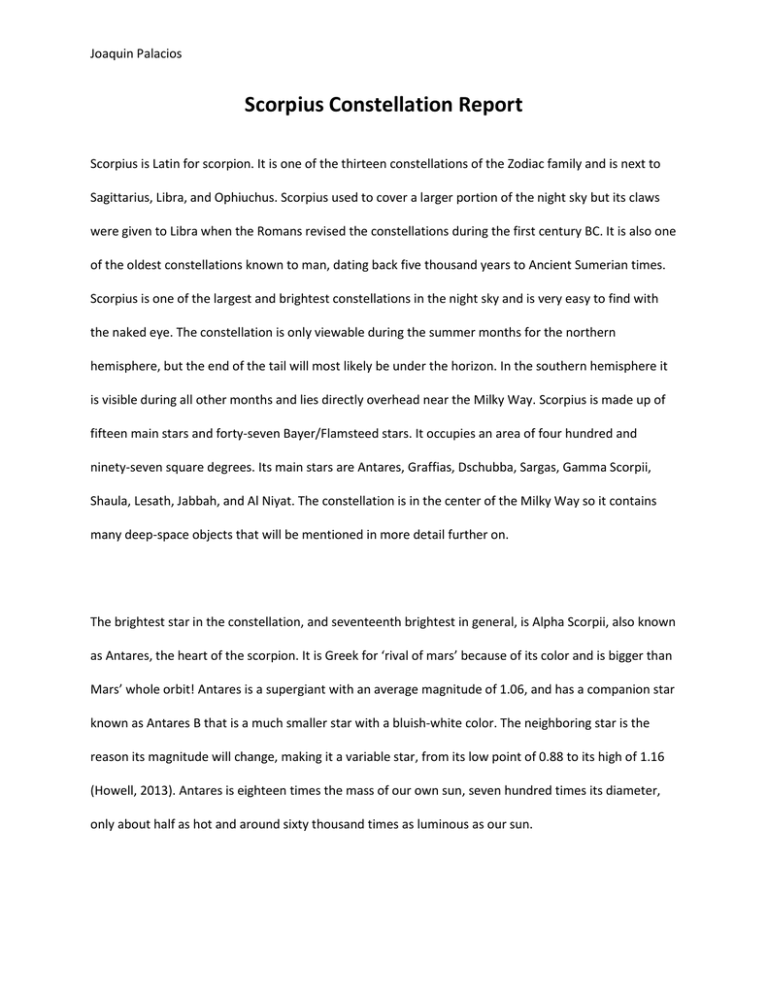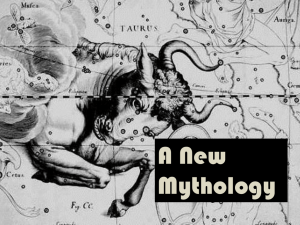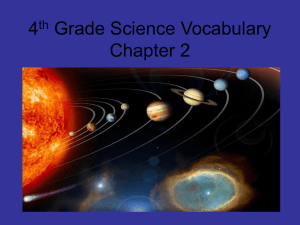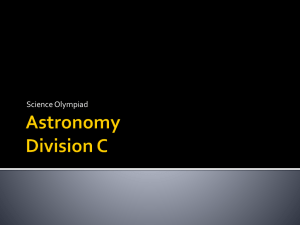constellation report
advertisement

Joaquin Palacios Scorpius Constellation Report Scorpius is Latin for scorpion. It is one of the thirteen constellations of the Zodiac family and is next to Sagittarius, Libra, and Ophiuchus. Scorpius used to cover a larger portion of the night sky but its claws were given to Libra when the Romans revised the constellations during the first century BC. It is also one of the oldest constellations known to man, dating back five thousand years to Ancient Sumerian times. Scorpius is one of the largest and brightest constellations in the night sky and is very easy to find with the naked eye. The constellation is only viewable during the summer months for the northern hemisphere, but the end of the tail will most likely be under the horizon. In the southern hemisphere it is visible during all other months and lies directly overhead near the Milky Way. Scorpius is made up of fifteen main stars and forty-seven Bayer/Flamsteed stars. It occupies an area of four hundred and ninety-seven square degrees. Its main stars are Antares, Graffias, Dschubba, Sargas, Gamma Scorpii, Shaula, Lesath, Jabbah, and Al Niyat. The constellation is in the center of the Milky Way so it contains many deep-space objects that will be mentioned in more detail further on. The brightest star in the constellation, and seventeenth brightest in general, is Alpha Scorpii, also known as Antares, the heart of the scorpion. It is Greek for ‘rival of mars’ because of its color and is bigger than Mars’ whole orbit! Antares is a supergiant with an average magnitude of 1.06, and has a companion star known as Antares B that is a much smaller star with a bluish-white color. The neighboring star is the reason its magnitude will change, making it a variable star, from its low point of 0.88 to its high of 1.16 (Howell, 2013). Antares is eighteen times the mass of our own sun, seven hundred times its diameter, only about half as hot and around sixty thousand times as luminous as our sun. Joaquin Palacios In Greek Mythology there are multiple stories regarding Scorpius and most of them are tied in closely with Orion. One story goes a little like this. Orion and Artemis we’re the best of friends, they would like to go out hunting together. Orion was a very cocky hunter and said he could kill all the animals on Earth. Gaia, the goddess of Earth, got very mad and knew Orion needed to be stopped, so she sent a giant scorpion after him. Orion was the best hunter around but he was no match for the colossal scorpion. The fight had begun but after a crucial hit from the scorpion’s stinger Orion was defeated. Zeus had been watching the battle from Mount Olympus and had seen how brave Orion was and wanted to honor him in some way. Zeus then placed him in the stars in the Northern Hemisphere. Gaia didn’t see a need for the scorpion on Earth anymore, so she put the Scorpius constellation in the Southern Hemisphere. You’ll never see the two constellations at the same time because as one rises in the east, the other sets in the west. The Babylonians called the constellation “MUL GIR TAB” which means scorpion, their signs translate to “creature with a burning sting” (Pubs, 2008). The people of Indonesia called the constellation Banyakangrem or Kalapa Doyong which translate to ‘the brooded swan’ and ‘leaning coconut tree’ due to the similarities in their shapes (Daldjoeni, 1984). In Chinese mythology the constellation was seen as part of the Azure Dragon of the East. In the Pacific Island of Hawaii the constellation is seen as the God Maui’s fishhook. The indigenous Maori people of New Zealand didn’t see the constellation as anything special but they worshipped the star Antares, other cultures did this too. The Maori renamed the star Rehua, and they saw it as the chief of all other stars. The Ancient Egyptian people saw the star as Serket, the scorpion goddess. Joaquin Palacios Since Scorpius is in the center of the Milky Way there are many deep space objects in and around the constellation. The closest of these objects is the globular cluster known as Messier 4, it’s about seven thousand two hundred light years away from our solar system and is estimated to be about thirteen billion years old. One of the best pictures from space, in my opinion, comes from NGC 6302 also known as the Butterfly Nebula, not to be confused with the Butterfly cluster. The nebula has a central star that was once about five times the size of our sun. Its temperature has been recorded up to four hundred thousand fahrenheit making one of the hottest stars in our galaxy. Sadly the star cannot be seen as it is surrounded by a thick ring cloud of gas and dust, this ring gives the planetary nebula its hourglass figure, which is now the size of two light years. It’s believed that the star started burning off its outer layers over two thousand years ago. The gas is moving through space at an astonishing rate of six hundred thousand miles an hour. Some pillars of creation can also be found in Scorpius, they lie within NGC 6357 also known as the War and Peace Nebula. Stars that are formed in this stellar nursery are made up of graphite, silicates and ice. This nebula is home to the open cluster Pismis 24 which contains some of the brightest stars in our galaxy. This nebula is about eight thousand light years away from us. Messier 80, otherwise known as NGC 6093 or M8 is one of the densest globular clusters out there. It contains hundreds of thousands of stars and was discovered in 1781 by Charles Messier (Frommert, 2007). Joaquin Palacios Joaquin Palacios Bibliography 1. Babylonian Star-lore by Gavin White, Solaria Pubs, 2008 page 175 2. Daldjoeni, N (1984). The Environmentalist 4: 15–18 3. "Scorpius Constellation - Facts About Scorpius | Solarsystemquick.com." Scorpius Constellation- Facts About Scorpius. N.p., n.d. 4. Howell, Elizabeth. "Antares: Red Star at the End of Its Life | Space.com." Space.com. N.p., 9 July 2013. 5. "Scorpius Constellation." Constellation Guide. N.p., n.d. 6. "Antares Star - Facts About Antares | Solarsystemquick.com." Antares Star - Facts About Antares | Solarsystemquick.com. N.p., n.d 7. Silverfox57. "Scorpius." Brickthology. N.p., 27 Nov. 2013. 8. "Scorpius." Universe Today. Tammy Plotner, 13 Jan. 2009. 9. "Amazing Space: The Butterfly Nebula;." Amazing Space: The Butterfly Nebula;. NASA, ESA, n.d. 10. McClure, Bruce. "Scorpius? Here's Your Constellation | EarthSky.org." EarthSky. N.p., 1 July 2014. (Picture) 11. Staff, SPACE.com. "U0027War and Peaceu0027 Nebulau0027s Stars Shine in New Space Photo | Space.com." Space.com. N.p., 20 June 2012. 12. Frommert, Hartmut. "Messier 80." Messier Object 80. N.p., 2 Sept. 2007.








